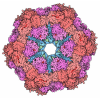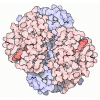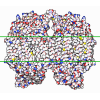[English] 日本語
 Yorodumi
Yorodumi- PDB-1ubl: Three-dimensional Structure of The Carbon Monoxide Complex of [Ni... -
+ Open data
Open data
- Basic information
Basic information
| Entry | Database: PDB / ID: 1ubl | |||||||||
|---|---|---|---|---|---|---|---|---|---|---|
| Title | Three-dimensional Structure of The Carbon Monoxide Complex of [NiFe]hydrogenase From Desulufovibrio vulgaris Miyazaki F | |||||||||
 Components Components | (Periplasmic [NiFe] hydrogenase ...) x 2 | |||||||||
 Keywords Keywords | OXIDOREDUCTASE / High resolution crystal structure / [NiFe]hydrogenase / Carbon Monoxide Complex | |||||||||
| Function / homology |  Function and homology information Function and homology informationcytochrome-c3 hydrogenase / cytochrome-c3 hydrogenase activity / ferredoxin hydrogenase complex / [Ni-Fe] hydrogenase complex / ferredoxin hydrogenase activity / anaerobic respiration / 3 iron, 4 sulfur cluster binding / nickel cation binding / 4 iron, 4 sulfur cluster binding / electron transfer activity ...cytochrome-c3 hydrogenase / cytochrome-c3 hydrogenase activity / ferredoxin hydrogenase complex / [Ni-Fe] hydrogenase complex / ferredoxin hydrogenase activity / anaerobic respiration / 3 iron, 4 sulfur cluster binding / nickel cation binding / 4 iron, 4 sulfur cluster binding / electron transfer activity / periplasmic space / metal ion binding / membrane Similarity search - Function | |||||||||
| Biological species |  Desulfovibrio vulgaris str. 'Miyazaki F' (bacteria) Desulfovibrio vulgaris str. 'Miyazaki F' (bacteria) | |||||||||
| Method |  X-RAY DIFFRACTION / X-RAY DIFFRACTION /  SYNCHROTRON / SYNCHROTRON /  FOURIER SYNTHESIS / Resolution: 1.2 Å FOURIER SYNTHESIS / Resolution: 1.2 Å | |||||||||
 Authors Authors | Ogata, H. / Mizoguchi, Y. / Mizuno, N. / Miki, K. / Adachi, S. / Yasuoka, N. / Yagi, T. / Yamauchi, O. / Hirota, S. / Higuchi, Y. | |||||||||
 Citation Citation |  Journal: J.Am.Chem.Soc. / Year: 2002 Journal: J.Am.Chem.Soc. / Year: 2002Title: Structural Studies of the Carbon Monoxide Complex of [NiFe]hydrogenase from Desulfovibrio vulgaris Miyazaki F: Suggestion for the Initial Activation Site for Dihydrogen Authors: Ogata, H. / Mizoguchi, Y. / Mizuno, N. / Miki, K. / Adachi, S. / Yasuoka, N. / Yagi, T. / Yamauchi, O. / Hirota, S. / Higuchi, Y. | |||||||||
| History |
|
- Structure visualization
Structure visualization
| Structure viewer | Molecule:  Molmil Molmil Jmol/JSmol Jmol/JSmol |
|---|
- Downloads & links
Downloads & links
- Download
Download
| PDBx/mmCIF format |  1ubl.cif.gz 1ubl.cif.gz | 361.6 KB | Display |  PDBx/mmCIF format PDBx/mmCIF format |
|---|---|---|---|---|
| PDB format |  pdb1ubl.ent.gz pdb1ubl.ent.gz | 291.5 KB | Display |  PDB format PDB format |
| PDBx/mmJSON format |  1ubl.json.gz 1ubl.json.gz | Tree view |  PDBx/mmJSON format PDBx/mmJSON format | |
| Others |  Other downloads Other downloads |
-Validation report
| Summary document |  1ubl_validation.pdf.gz 1ubl_validation.pdf.gz | 445.7 KB | Display |  wwPDB validaton report wwPDB validaton report |
|---|---|---|---|---|
| Full document |  1ubl_full_validation.pdf.gz 1ubl_full_validation.pdf.gz | 463.6 KB | Display | |
| Data in XML |  1ubl_validation.xml.gz 1ubl_validation.xml.gz | 19 KB | Display | |
| Data in CIF |  1ubl_validation.cif.gz 1ubl_validation.cif.gz | 33.6 KB | Display | |
| Arichive directory |  https://data.pdbj.org/pub/pdb/validation_reports/ub/1ubl https://data.pdbj.org/pub/pdb/validation_reports/ub/1ubl ftp://data.pdbj.org/pub/pdb/validation_reports/ub/1ubl ftp://data.pdbj.org/pub/pdb/validation_reports/ub/1ubl | HTTPS FTP |
-Related structure data
| Related structure data | 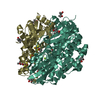 1ubhC 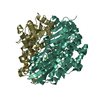 1ubjC 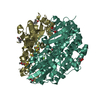 1ubkC 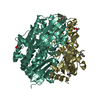 1ubmC 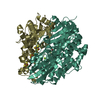 1uboC 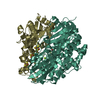 1ubrC  1ubtC 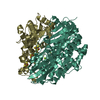 1ubuC  1h2rS C: citing same article ( S: Starting model for refinement |
|---|---|
| Similar structure data |
- Links
Links
- Assembly
Assembly
| Deposited unit | 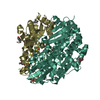
| ||||||||
|---|---|---|---|---|---|---|---|---|---|
| 1 |
| ||||||||
| Unit cell |
|
- Components
Components
-Periplasmic [NiFe] hydrogenase ... , 2 types, 2 molecules SL
| #1: Protein | Mass: 28789.746 Da / Num. of mol.: 1 / Source method: isolated from a natural source Source: (natural)  Desulfovibrio vulgaris str. 'Miyazaki F' (bacteria) Desulfovibrio vulgaris str. 'Miyazaki F' (bacteria)Species: Desulfovibrio vulgaris / Strain: Miyazaki F / References: UniProt: P21853, cytochrome-c3 hydrogenase |
|---|---|
| #2: Protein | Mass: 59208.398 Da / Num. of mol.: 1 / Fragment: RESIDUES 19-552 / Source method: isolated from a natural source Source: (natural)  Desulfovibrio vulgaris str. 'Miyazaki F' (bacteria) Desulfovibrio vulgaris str. 'Miyazaki F' (bacteria)Species: Desulfovibrio vulgaris / Strain: Miyazaki F / References: UniProt: P21852, cytochrome-c3 hydrogenase |
-Non-polymers , 7 types, 857 molecules 
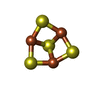
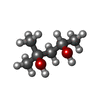

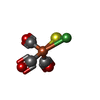
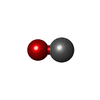







| #3: Chemical | | #4: Chemical | ChemComp-F3S / | #5: Chemical | ChemComp-MPD / ( #6: Chemical | ChemComp-MG / | #7: Chemical | ChemComp-FNE / ( | #8: Chemical | ChemComp-CMO / | #9: Water | ChemComp-HOH / | |
|---|
-Details
| Has protein modification | Y |
|---|
-Experimental details
-Experiment
| Experiment | Method:  X-RAY DIFFRACTION / Number of used crystals: 1 X-RAY DIFFRACTION / Number of used crystals: 1 |
|---|
- Sample preparation
Sample preparation
| Crystal | Density Matthews: 2 Å3/Da / Density % sol: 34.8 % |
|---|---|
| Crystal grow | Temperature: 283 K / Method: vapor diffusion, sitting drop / pH: 7.4 Details: MPD, pH 7.4, VAPOR DIFFUSION, SITTING DROP, temperature 283K |
| Crystal grow | *PLUS |
-Data collection
| Diffraction | Mean temperature: 100 K |
|---|---|
| Diffraction source | Source:  SYNCHROTRON / Site: SYNCHROTRON / Site:  SPring-8 SPring-8  / Beamline: BL44B2 / Wavelength: 0.7 Å / Beamline: BL44B2 / Wavelength: 0.7 Å |
| Detector | Type: MARRESEARCH / Detector: CCD / Date: Mar 17, 2000 |
| Radiation | Monochromator: Si 111 / Protocol: SINGLE WAVELENGTH / Monochromatic (M) / Laue (L): M / Scattering type: x-ray |
| Radiation wavelength | Wavelength: 0.7 Å / Relative weight: 1 |
| Reflection | Resolution: 1.12→25.1 Å / Num. all: 303804 / Num. obs: 297600 / % possible obs: 94.3 % / Observed criterion σ(F): 1 / Observed criterion σ(I): 2 / Rmerge(I) obs: 0.08 |
| Reflection shell | Resolution: 1.12→1.18 Å / Rmerge(I) obs: 0.384 / % possible all: 84.9 |
- Processing
Processing
| Software |
| |||||||||||||||||||||||||||||||||
|---|---|---|---|---|---|---|---|---|---|---|---|---|---|---|---|---|---|---|---|---|---|---|---|---|---|---|---|---|---|---|---|---|---|---|
| Refinement | Method to determine structure:  FOURIER SYNTHESIS FOURIER SYNTHESISStarting model: 1H2R Resolution: 1.2→20 Å / Num. parameters: 64092 / Num. restraintsaints: 78339 / Cross valid method: THROUGHOUT / σ(F): 1 / Stereochemistry target values: ENGH & HUBER
| |||||||||||||||||||||||||||||||||
| Refine analyze | Num. disordered residues: 0 / Occupancy sum hydrogen: 298 / Occupancy sum non hydrogen: 7100.31 | |||||||||||||||||||||||||||||||||
| Refinement step | Cycle: LAST / Resolution: 1.2→20 Å
| |||||||||||||||||||||||||||||||||
| Refine LS restraints |
| |||||||||||||||||||||||||||||||||
| Software | *PLUS Name: SHELXL / Version: 97 / Classification: refinement | |||||||||||||||||||||||||||||||||
| Refinement | *PLUS Rfactor obs: 0.123 / Rfactor Rfree: 0.163 / Rfactor Rwork: 0.127 | |||||||||||||||||||||||||||||||||
| Solvent computation | *PLUS | |||||||||||||||||||||||||||||||||
| Displacement parameters | *PLUS |
 Movie
Movie Controller
Controller


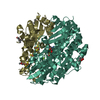

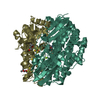
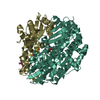


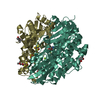
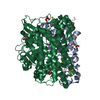


 PDBj
PDBj




